Mapping the Messy ‘Field’ of Interfaith Encounters
by Daniella Shaw
Blog | March 2022
The Encounters Project seeks to explore Muslim-Jewish intercultural, interethnic and interreligious interactions in six cities across the UK, France and Germany. As the London ethnographer, I set out to map the field in which I would be spending the following two years. Here I seek to share the anatomy of these encounters, which ultimately, as you will read, is a rather messy mapping exercise within the context of this superdiverse, frenetic capital city. As one interfaith professional recently characterised it to me, “it’s a ‘piece of string’ kind of question”.
Indeed, the anatomy of these encounters is a varied mix of formal, ad hoc and often complex occurrences. These are sometimes structured and institutionalised, sometimes merely a passing on the street. We can see local and international incidences transplanted onto faith community relations. There are historic and religious sites commercial exchanges, friendships, cultural and entertainment spaces. In fact, the exchanges between Muslims and Jews reflects the full gamut of London life.
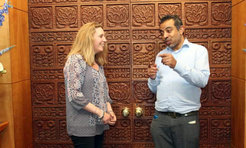
Let's take a snapshot of some of these encounters.
When in 2017, a London-based Mosque suffered an arson attack, local synagogues opened their spaces to ensure that the community could continue to operate, to pray and to meet. Likewise, a fledgling mosque in the area opened its doors for an interfaith blood drive, part of a series of events – some cooperative and others contentious – which epitomise the complex local interplay of cooperation and challenge around the geographies of religious spaces in London.
There is a long and strong history in the UK of more formal institutional interfaith exchanges, some of which are bilateral Muslim-Jewish endeavours, whilst others are more broadly interfaith/intercultural/multifaith initiatives. The Faith and Belief Forum, the Interfaith Network for the UK, the Maimonides Foundation, and the Council of Christians and Jews, are just some examples of the longest running interfaith organisations running formal projects, most with a decades-long track record running school-twinning projects, arts initiatives, dialogue, training, shared social action and the like.
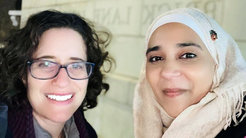
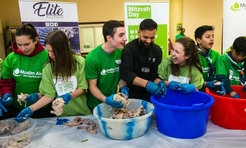
Beyond the more typical structured religious spaces, connections are made between groups across the faith communities that identify shared experience, and at times shared struggle. The growing work across LGBT+ people of faith is one such example. Another is the proliferation and depth of Muslim-Jewish women's groups across London and the UK, building genuine connections and at times impactful shared actions, predominantly through Nisa-Nashim. One group has even resulted in the publication of a book, edited by a Jewish member, including contributions from her Muslim counterpart and other women from a variety of backgrounds.
Increasingly, environmental concerns feature as a locus of engagement, with ‘eco-synagogue’ and ‘eco-mosque’ initiatives learning from each other, and joint tree-planting in the capital city featuring as part of annual charity days, namely the Jewish ‘Mitzvah Day’ and Muslim ‘Sadaqa Day’. On one occasion young Muslims and Jews came together at the East London
Mosque to cook a traditional Jewish chicken soup for the local homeless shelter.
This cross-fertilisation of ideas between the communities is also evident in the sharing of expertise on community security, such as a recent online Women's Safety Information evening targeted at Jewish and Muslim women.
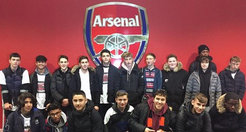
Even Arsenal football club, the rival club to Tottenham Hotspur which is often seen as a ‘Jewish club’, can be counted as a space of interfaith encounter, with their faith schools project bringing together young people from local and faith schools.
Music initiatives, as well as art collaborations, and other cultural activities often have a more informal structure but are nonetheless important, vibrant and arguably somewhat more organic spaces of encounter. And one only has to look at the rich culinary narratives of London’s Brick Lane to see how both gastronomic and commercial exchange (namely the textile trade), as the site of some of the longest-running incidental encounters between Muslims and Jews in London.
Sometimes, when we place a microscope over an encounter, we may find it to be more talked about than real. In the context of political agendas around ‘Integration’, ‘Community Cohesion’ and ‘Preventing Violent Extremism’, optics matter. Yet even in these cases, talking into existence an exchange becomes itself a part of the narrative of contacts between Muslims and Jews.
Virtual spaces are bourgeoning sites of exchange, creating new textures and possibilities for all interactions, of which Muslim-Jewish connections are no different. An online wellbeing group for Muslim and Jewish women is just one such thriving initiative.
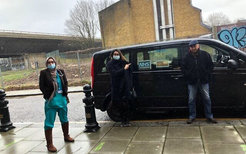
As we explore the more local anatomies of encounters, shared activism and cooperation around health needs, dietary requirements-in-common, and even housing, can be spaces of exchange and cooperation. And in these very COVID of times, a Jewish and a Muslim doctor joined forces to create the ‘Vaxi Taxi’ – London’s first mobile COVID-19 vaccination unit.
Set within a complex nexus of local and international events, the anatomy of Muslim-Jewish encounters in London is very much of London. It is reflective of all of its vibrant conviviality, daily bustle and complex negotiations. For the social researcher, this makes for a methodologically messy business. But in so doing, this also poses great opportunity and challenge, both for the nature of these interactions themselves and for the researcher’s methods of enquiry.
















